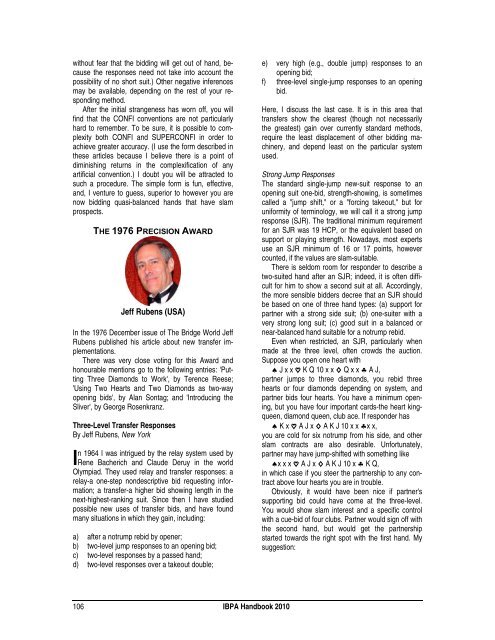Handbook - International Bridge Press Association
Handbook - International Bridge Press Association
Handbook - International Bridge Press Association
Create successful ePaper yourself
Turn your PDF publications into a flip-book with our unique Google optimized e-Paper software.
without fear that the bidding will get out of hand, because<br />
the responses need not take into account the<br />
possibility of no short suit.) Other negative inferences<br />
may be available, depending on the rest of your responding<br />
method.<br />
After the initial strangeness has worn off, you will<br />
find that the CONFI conventions are not particularly<br />
hard to remember. To be sure, it is possible to complexity<br />
both CONFI and SUPERCONFI in order to<br />
achieve greater accuracy. (I use the form described in<br />
these articles because I believe there is a point of<br />
diminishing returns in the complexification of any<br />
artificial convention.) I doubt you will be attracted to<br />
such a procedure. The simple form is fun, effective,<br />
and, I venture to guess, superior to however you are<br />
now bidding quasi-balanced hands that have slam<br />
prospects.<br />
THE 1976 PRECISION AWARD<br />
Jeff Rubens (USA)<br />
In the 1976 December issue of The <strong>Bridge</strong> World Jeff<br />
Rubens published his article about new transfer implementations.<br />
There was very close voting for this Award and<br />
honourable mentions go to the following entries: 'Putting<br />
Three Diamonds to Work', by Terence Reese;<br />
'Using Two Hearts and Two Diamonds as two-way<br />
opening bids', by Alan Sontag; and 'Introducing the<br />
Sliver', by George Rosenkranz.<br />
Three-Level Transfer Responses<br />
By Jeff Rubens, New York<br />
I<br />
n 1964 I was intrigued by the relay system used by<br />
Rene Bacherich and Claude Deruy in the world<br />
Olympiad. They used relay and transfer responses: a<br />
relay-a one-step nondescriptive bid requesting information;<br />
a transfer-a higher bid showing length in the<br />
next-highest-ranking suit. Since then I have studied<br />
possible new uses of transfer bids, and have found<br />
many situations in which they gain, including:<br />
a) after a notrump rebid by opener;<br />
b) two-level jump responses to an opening bid;<br />
c) two-level responses by a passed hand;<br />
d) two-level responses over a takeout double;<br />
106 IBPA <strong>Handbook</strong> 2010<br />
e) very high (e.g., double jump) responses to an<br />
opening bid;<br />
f) three-level single-jump responses to an opening<br />
bid.<br />
Here, I discuss the last case. It is in this area that<br />
transfers show the clearest (though not necessarily<br />
the greatest) gain over currently standard methods,<br />
require the least displacement of other bidding machinery,<br />
and depend least on the particular system<br />
used.<br />
Strong Jump Responses<br />
The standard single-jump new-suit response to an<br />
opening suit one-bid, strength-showing, is sometimes<br />
called a "jump shift," or a "forcing takeout," but for<br />
uniformity of terminology, we will call it a strong jump<br />
response (SJR). The traditional minimum requirement<br />
for an SJR was 19 HCP, or the equivalent based on<br />
support or playing strength. Nowadays, most experts<br />
use an SJR minimum of 16 or 17 points, however<br />
counted, if the values are slam-suitable.<br />
There is seldom room for responder to describe a<br />
two-suited hand after an SJR; indeed, it is often difficult<br />
for him to show a second suit at all. Accordingly,<br />
the more sensible bidders decree that an SJR should<br />
be based on one of three hand types: (a) support for<br />
partner with a strong side suit; (b) one-suiter with a<br />
very strong long suit; (c) good suit in a balanced or<br />
near-balanced hand suitable for a notrump rebid.<br />
Even when restricted, an SJR, particularly when<br />
made at the three level, often crowds the auction.<br />
Suppose you open one heart with<br />
♠ J x x K Q 10 x x Q x x ♣ A J,<br />
partner jumps to three diamonds, you rebid three<br />
hearts or four diamonds depending on system, and<br />
partner bids four hearts. You have a minimum opening,<br />
but you have four important cards-the heart kingqueen,<br />
diamond queen, club ace. If responder has<br />
♠ K x A J x A K J 10 x x ♣x x,<br />
you are cold for six notrump from his side, and other<br />
slam contracts are also desirable. Unfortunately,<br />
partner may have jump-shifted with something like<br />
♠x x x A J x A K J 10 x ♣ K Q,<br />
in which case if you steer the partnership to any contract<br />
above four hearts you are in trouble.<br />
Obviously, it would have been nice if partner's<br />
supporting bid could have come at the three-level.<br />
You would show slam interest and a specific control<br />
with a cue-bid of four clubs. Partner would sign off with<br />
the second hand, but would get the partnership<br />
started towards the right spot with the first hand. My<br />
suggestion:


